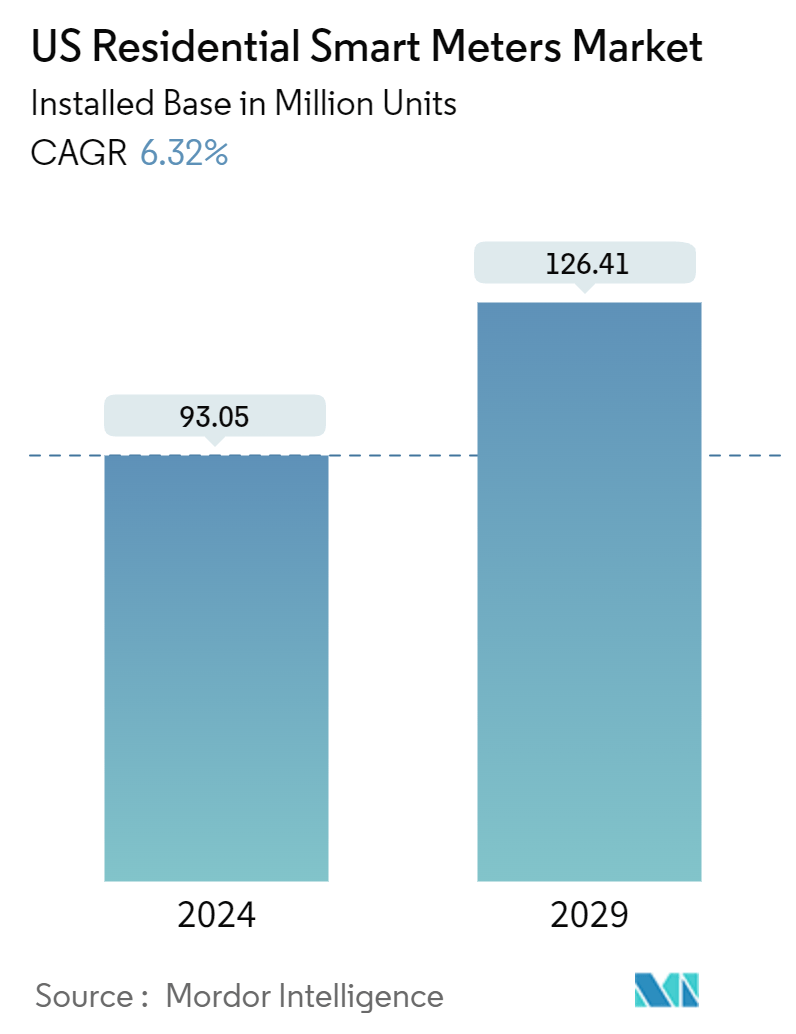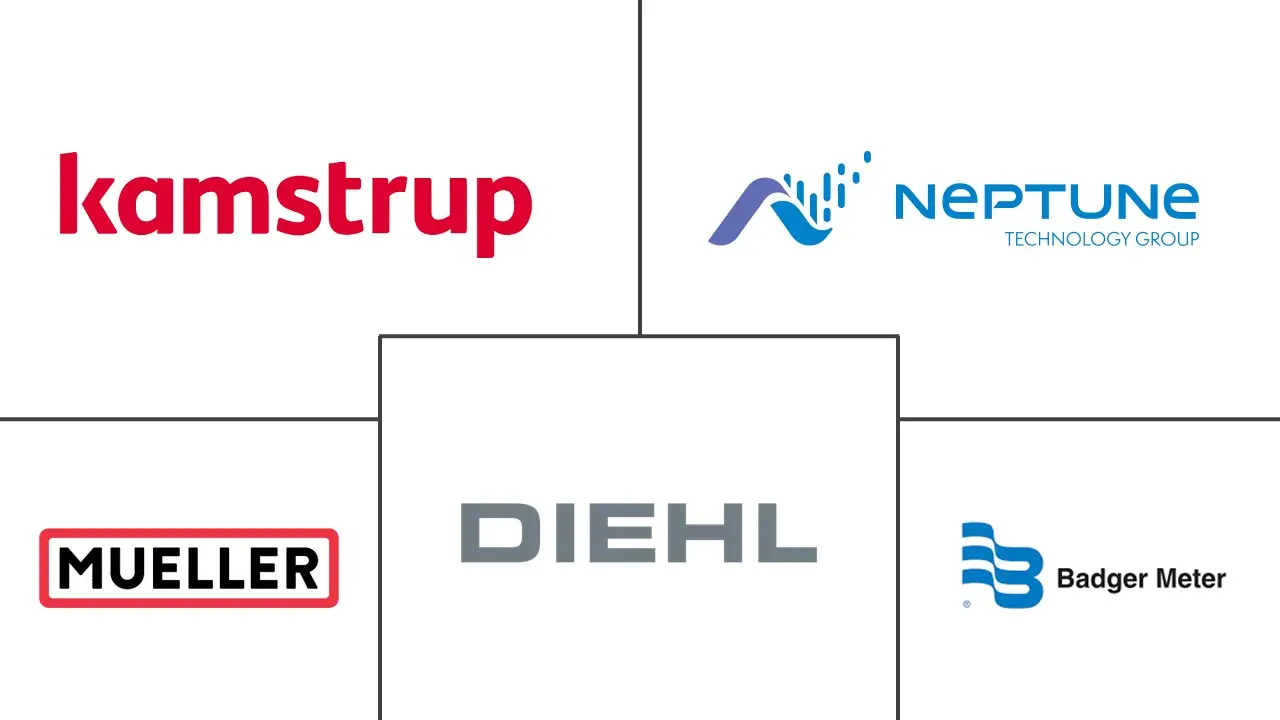Market Size of US Residential Smart Meters Industry

| Study Period | 2019 - 2029 |
| Base Year For Estimation | 2023 |
| Market Volume (2024) | 93.05 Million units |
| Market Volume (2029) | 126.41 Million units |
| CAGR (2024 - 2029) | 6.32 % |
| Market Concentration | Low |
Major Players
*Disclaimer: Major Players sorted in no particular order |
US Residential Smart Meters Market Analysis
The US Residential Smart Meters Market size in terms of installed base is expected to grow from 93.05 Million units in 2024 to 126.41 Million units by 2029, at a CAGR of 6.32% during the forecast period (2024-2029).
Smart meters are electronic devices that monitor electricity, gas, and water usage. These smart meters can transmit usage data via cellular, radiofrequency electromagnetic radiation (RF), and power line communication, assisting the utility company in efficiently managing energy consumption. Smart meters provide many advantages, including lower meter reading costs, prevention of disconnection, elimination of billing inefficiencies, and lower reconnection costs for businesses and consumers.
- Smart meters are increasingly being adopted in the United States for various deployments, such as gas, electricity, and water, due to their communication feature, which imparts features such as real-time tracking of utility usage by both utility suppliers and consumers, also encourages start/reading/maintenance/cutoff of supply remotely by the supplier. The deployment of smart meters also enables the implementation of a home or building energy management system (HEMS or BEMS), allowing visualization of the electric power usage in the entire residential building or in individual homes.
- Digitization is further driving and modernizing energy efficiency measures, which in turn is accelerating the deployment of smart grids in the country, considering they are capable of dynamically optimizing and fostering a supply of large amounts of electricity from renewable energy plants and sources such as solar power.
- Smart Metering is an IoT-based device for measuring home buildings' gas, water, and energy consumption. With smart metering and utility analytics solutions, utility companies can tack and get access to smart asset data, consumers' information, utility distribution and consumption history, and much more for a deep understanding of their utility usage habits operations. This can help them capitalize on the benefits of smart metering solutions by exploiting the advantages directly.
- The most prominent limitation in the smart metering market is the availability of capital funding to deploy smart meters. Smart water and electricity meters are comparatively more expensive than the regular metering equipment employed by most service providers and users.
- The outbreak of COVID-19 suddenly changed how the world economy was structured. The smart-meter market suffered from a sudden decline in residential infrastructure installation and development projects as several restrictions ranging from travel to the use of manual workforce were imposed to curb the spread of the virus. However, in the post-pandemic era, the market successfully adjusted and is on its part toward growth, which has helped open opportunities for new technologies to be introduced into the market in the United States. The top suppliers must ensure that their goods satisfy both consumer expectations and legal and security requirements to succeed.
US Residential Smart Meters Industry Segmentation
Smart meters are digital meters representing a transformative technology for the utility industry and its customers. It enables either one-way or two-way communication between the meter and the supplier. These technologically advanced meters display real-time energy usage and provide greater insight into the usage of energy. They also use a secure smart data network to send the readings automatically and wirelessly to the energy supplier to generate accurate bills.
The United States residential smart meters market is segmented by type (smart gas meter, smart water meter, smart electricity meter). The market size and forecasts are provided in terms of the installed base of smart meters for all the above segments.
US Residential Smart Meters Market Size Summary
The United States residential smart meters market is experiencing significant growth, driven by the increasing adoption of these IoT-based devices across gas, electricity, and water sectors. Smart meters offer numerous advantages, such as real-time tracking of utility usage, remote supply management, and integration with home energy management systems. The shift towards digitization and smart grids is further propelling the market, as these technologies enable efficient energy management and support the integration of renewable energy sources. Despite the higher initial costs compared to traditional metering equipment, the benefits of reduced operational costs and improved efficiency are encouraging widespread adoption. The market is also witnessing a surge in investments and government initiatives aimed at enhancing grid resilience and reliability, which are expected to bolster the deployment of smart meters across the country.
The market landscape is characterized by a fragmented competitive environment, with key players like Badger Meter Inc., Mueller Systems LLC, and Neptune Technology Group Inc. actively participating in the rollout of smart metering solutions. Recent developments include the introduction of advanced metering infrastructure solutions that transform outdated meters into smart devices without significant infrastructure changes. The residential sector, in particular, presents a substantial opportunity for growth, driven by the increasing number of households and the rising demand for natural gas. As utilities continue to modernize their infrastructure and embrace smart technologies, the US residential smart meters market is poised for continued expansion, supported by ongoing technological advancements and strategic partnerships.
US Residential Smart Meters Market Size - Table of Contents
-
1. MARKET INSIGHTS
-
1.1 Market Overview
-
1.2 Impact of COVID-19 Aftereffects and other Macroeconomic Factors on the Market
-
1.3 Industry Value Chain Analysis
-
1.4 Industry Attractiveness - Porter's Five Forces Analysis
-
1.4.1 Bargaining Power of Suppliers
-
1.4.2 Bargaining Power of Buyers
-
1.4.3 Threat of New Entrants
-
1.4.4 Threat of Substitute Products
-
1.4.5 Degree of Competition
-
-
1.5 Technology Evolution
-
-
2. MARKET SEGMENTATION
-
2.1 Smart Gas Meter
-
2.2 Smart Water Meter
-
2.3 Smart Electricity Meter
-
US Residential Smart Meters Market Size FAQs
How big is the US Residential Smart Meters Market?
The US Residential Smart Meters Market size is expected to reach 93.05 million units in 2024 and grow at a CAGR of 6.32% to reach 126.41 million units by 2029.
What is the current US Residential Smart Meters Market size?
In 2024, the US Residential Smart Meters Market size is expected to reach 93.05 million units.

